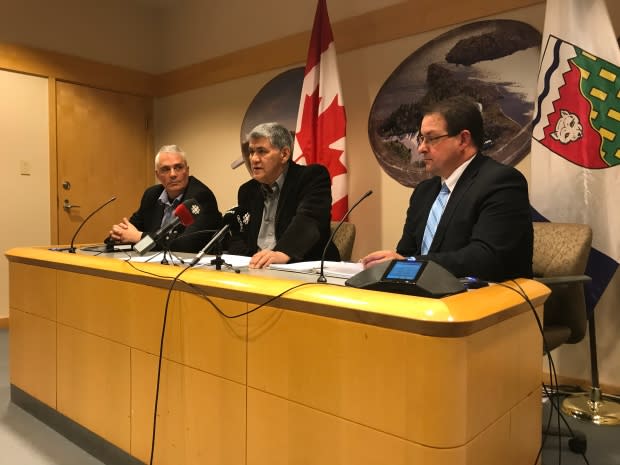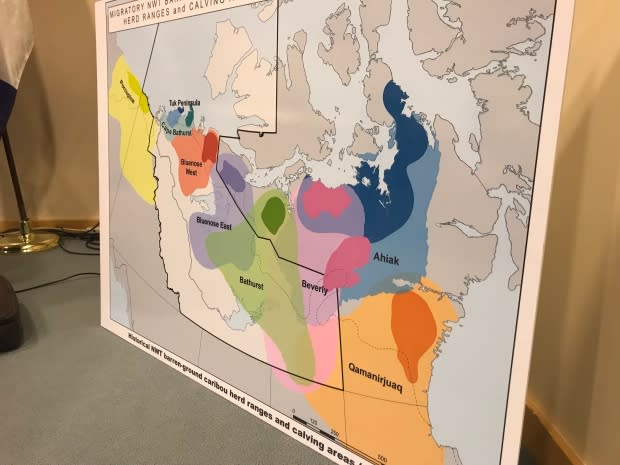'Deadly serious': 2 caribou herds shrink by half in latest count
The Bathurst and Bluenose East caribou herds have declined by more than 50 per cent since 2015, according to the N.W.T. Department of Environment and Natural Resources.
"This is deadly serious," said Environment and Natural Resources (ENR) Minister Robert C. McLeod at a briefing on new herd numbers on Tuesday.
"Both populations have shown rapid decline."

Surveys conducted in June 2018 estimate the Bathurst herd at just 8,200 animals, down from 20,000 in 2015. The Bluenose East population was estimated at 19,300 animals, down from 39,000 in 2015.
In response, Deputy Minister Joe Dragon suggested the government, in consultation with local management boards, may consider stricter hunting limits for the Bluenose East herd, and would extend the current ban on hunting Bathurst caribou.
Decline a 'natural process'
Traditional knowledge indicates that caribou populations rise and fall over time. Periods of low numbers in the 1970s were followed by population booms in the 1980s, said Dragon.
But a low number of new calves and an "alarming" survival rate suggest the herds have not yet reached their lowest point.
The rate of the decline is also more severe than traditional knowledge would indicate.
ENR surveyed the population using two methods: analyzing aerial photographs of the grouped herd and surveying calving grounds by counting cows and calves.
"We have a high, high degree of confidence that these numbers are representative of these herds," said Dragon.
Dragon said harvest, predation, habitat change and climate change have all hastened a natural cycle of decline. He said improved hunting methods could be a factor.
"For my grandfather, he was using a dog team to hunt caribou," said Dragon. "Now, we're using snowmobiles."
But humans alone are not to blame, he said.

A single wolf can eat between 25 and 29 caribou per year, said Dragon. In some areas, incentives for harvesting wolves will be considered.
Forest fires have also decreased the range of the Bathurst herd, though habitat change is not considered a major cause of the decline.
"There are no easy answers, and we need to avoid the temptation to look for easy explanations," he said.
Species 'threatened'
In 2016, the Committee on the Status of Endangered Wildlife in Canada classified the species as "threatened", and the territory followed suit two years later.
As a result, the territory is obligated to produce a recovery strategy by 2020, which a spokesperson for ENR said is still in development.
In the meantime, the territory is due to implement a "range plan" in early 2019 designed to protect and manage the habitat of the Bathurst caribou.
Herds are carefully managed by several layers of government and co-management boards. Restrictions prevent even Indigenous hunters from harvesting from some herds.
In 2015, the territory implemented a ban on all hunting of Bathurst caribou, including harvesting by Indigenous hunters. Harvesting from the Bluenose-East herd is limited to under 900 bulls per season.
Some herds of barren-ground caribou, like the Porcupine caribou, which calve in the Alaska's Arctic National Wildlife Refuge, have seen their numbers grow substantially.
Others, like the Bathurst and Bluenose East herds near Great Bear Lake and Great Slave Lake, are facing terminal declines.
In the past, territorial biologists estimated as many as 6,000 caribou were harvested by Indigenous hunters across the territory every year. A spokesperson for ENR pegged the current harvest of Bluenose-East caribou at 191 animals in the 2017-18 season, down from 373 in the previous season.
But other researchers and land users count both the herds and the harvests differently.
Some critics have said hunting restrictions "scapegoat" Indigenous harvesters, while mineral developments are currently permitted in the threatened herds' calving grounds in Nunavut.
McLeod said he had asked for a meeting with Nunavut's Premier Joe Savikataaq, but is still waiting to hear back.
Before any new plans can be implemented, the territorial government will meet with regional resource management boards established in land claims agreements.
But right now, the government is not taking anything off the table.
"As we help these caribou through this transitional period of low numbers… there's going to be some very serious questions about what we have to do," said Dragon.

